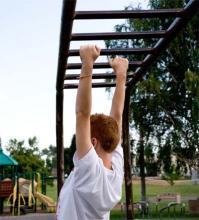
Upper body strength is the ability of the body to exert a maximum force against an object external to the body in one maximum effort of the upper body muscles.1 Upper body strength is important for the everyday demands that are placed on the arms, shoulders, and back.2
Children naturally develop their upper body strength while engaging in play. Toddlers begin to climb as they become more mobile. While playing outdoors, children have many opportunities to climb trees and playground equipment, such as monkey bars, ladders, rock walls, and track rides.
Overhead equipment on playgrounds is an excellent tool for developing upper body strength. Brachiating on overhead ladders and rings takes the development of several motor skills in order to be able to swing from rung to rung. Children need to reach a point in their growth that allows them to support their weight while hanging by their hands. This includes the development of grip strength and upper body strength. Children also must develop the skills of eye-hand coordination, visual perception of distance, and lateral weight shift.3
Most children develop sufficient upper body strength and grip to support their body weight by at least 3 years of age. If children are introduced to overhead equipment earlier, some can hold their body weight at 2 years of age with supervision. The ability to successfully use overhead equipment is often affected by body weight. Children who are obese may not be able to support their weight, especially as they need to shift their weight from one arm to the other.4
- 1. Gallahue, David L. and Frances Cleland Donnelly. Developmental Physical Education for All Children. 4th ed. Champaign, IL: Human Kinetics. 2003. p. 84.
- 2. “How To Build Upper Body Strength.” SolveYourProblem.com. < http://www.solveyourproblem.com/exercise-workouts/how_to_build_upper_body_strength.shtml > 10 Sep. 2010.
- 3. Frost, Joe L., Pei-San Brown, John A. Sutterby, Candra D. Thornton. The Developmental Benefits of Playgrounds. Olney, MD: Association for Childhood Education International, 2004. pp. 93.
- 4. Ibid., p. 93.

